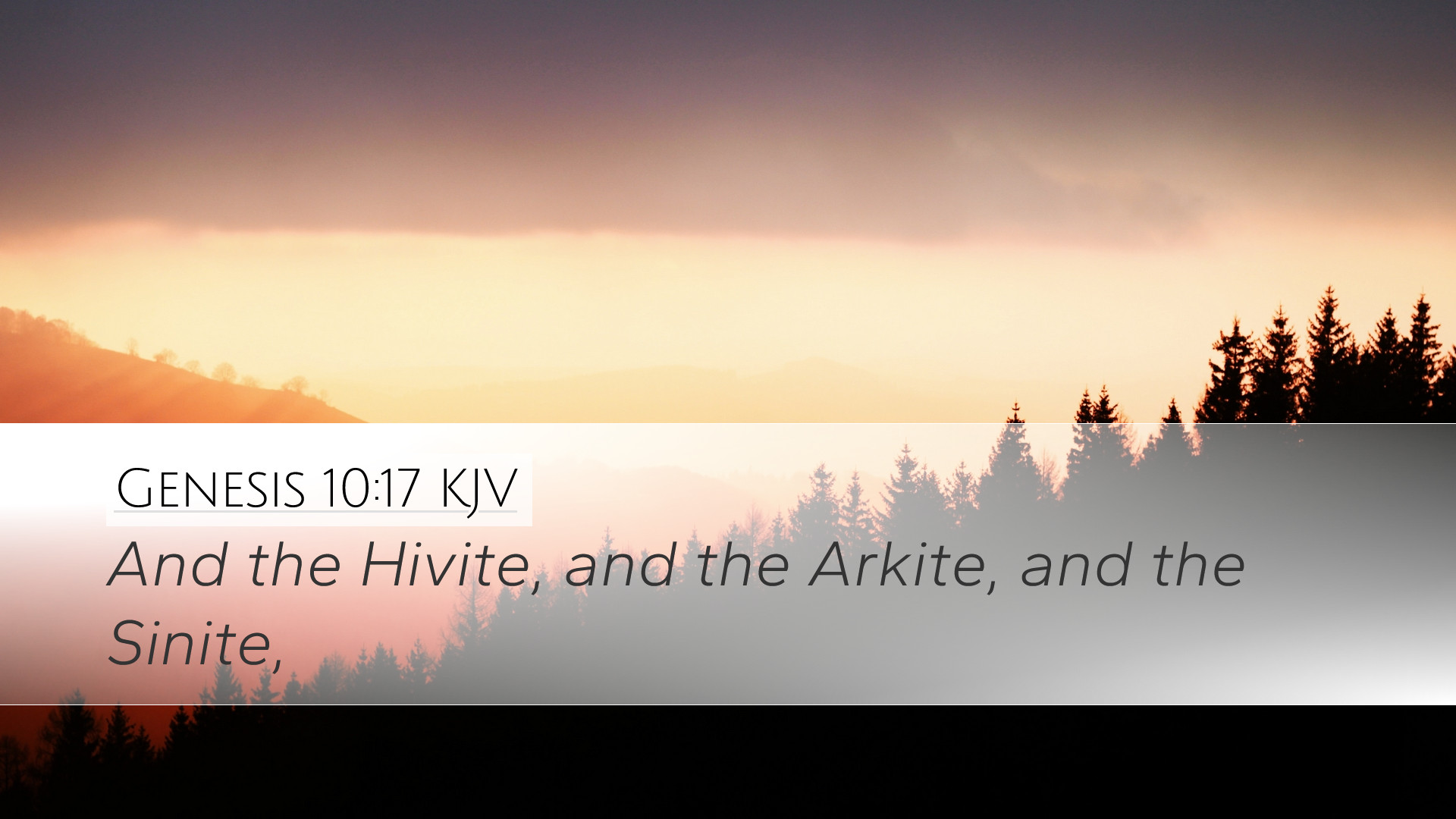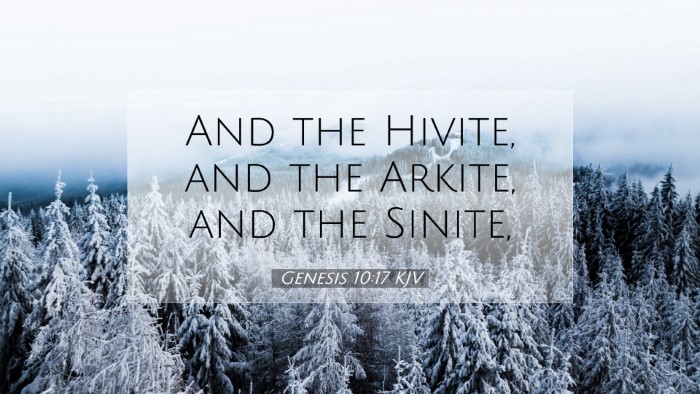Commentary on Genesis 10:17
Verse Context: Genesis 10:17 states, "The Hivite, and the Arkite, and the Sinite." This verse is situated in the genealogical record following the flood, specifically detailing the descendants of Canaan, the son of Ham, which in turn outlines the nations that emerged from these lineages.
General Overview
In this passage, the verse lists several groups of people descended from Canaan, which is significant for understanding the early human settlements following the flood. The naming of these tribes highlights the geographical and ethnic diversity that arose in the post-diluvian world.
Insights from Matthew Henry
Matthew Henry provides a keen insight into the implications of these descendants being mentioned. He notes that the listing of these nations serves not only as a historical account but also as a testimony to God's providential care over humanity, even after judgment through the flood. The mention of tribes like the Hivites, Arkites, and Sinites reflects the geographical dispersion of people and their eventual development into distinct cultural identities.
- Divine Sovereignty: Henry emphasizes that this genealogical detail reflects God's sovereignty in managing human history and the rise and fall of nations.
- Cultural Distinction: The uniqueness of each tribe mentioned underlines the diversity of humanity, which God intended and continues to uphold.
- Historical Significance: By keeping a record of these nations, Henry points out the importance of history in biblical narrative and its validation of the Scriptures through real-world events and peoples.
Insights from Albert Barnes
Albert Barnes interprets this verse as part of the larger narrative of the dispersion of nations. He provides additional cultural context, noting that the tribes mentioned were significant players in the history of Israel, particularly during the conquest of Canaan. His commentary invites readers to consider the implications of inter-tribal relations and the historical enmity that developed between these groups and the Israelites.
- Tribal Relations: Barnes elucidates that understanding these tribes provides insight into the origins of conflicts in the Old Testament, particularly with respect to the Israelites.
- Historical Geography: The specific mention of these tribes paints a geographical picture of early post-flood settlements, which is crucial for the later narrative involving the Promised Land.
- Patterns of Sin: He also suggests that the identities of these nations give further depth to the understanding of sin and its consequences, as many of these tribes fell into practices that were at odds with God's commandments.
Insights from Adam Clarke
Adam Clarke offers a linguistically and anthropologically rich analysis of the names listed in this verse. He provides a detailed breakdown of each tribe, including possible origins and meanings associated with their names. Clarke's approach invites an exploration of not just the individuals but also the collective character and practices of these nations.
- Etymology of Names: Clarke discusses the meanings behind the names, suggesting that they reflect certain characteristics or cultures of the tribes.
- Influence on Israel: He also emphasizes the importance of understanding these tribes in light of Israel's history, as they played significant roles in both the immediate and distant history of God's chosen people.
- Application for Modern Readers: Clarke invites contemporary readers to reflect on the ongoing legacy of these ancient tribes, encouraging a deeper understanding of how historical peoples influence modern contexts.
Theological Reflections
Throughout the commentaries, a consistent theme emerges regarding the theological significance of genealogies and the nations that arise within scripture:
- God's Plan for Humanity: The genealogies serve as a reminder that God has a plan for humanity that transcends individual lives and encompasses entire nations.
- Unity in Diversity: The diversity illustrated in these genealogies reflects the richness of God's creation and the fullness of humanity as part of divine reflection.
- Historical Continuity: Understanding these tribes aids in grasping the continuum of biblical history, reminding pastors, students, and scholars of their role in proclaiming the overarching narrative of redemption.
Conclusion
In conclusion, Genesis 10:17 encapsulates an important part of the genealogical tradition within the Bible. The insights from Matthew Henry, Albert Barnes, and Adam Clarke reveal not just the historical significance of these tribes but also their theological implications. For pastors, students, and theologians, the understanding of these genealogies enhances one's grasp of the intricate map of biblical history while highlighting God's unchanging sovereignty throughout the ages.


